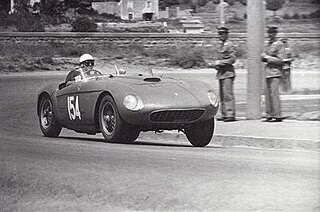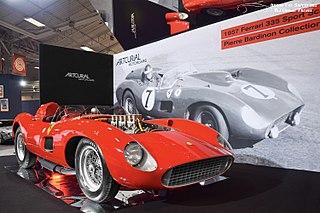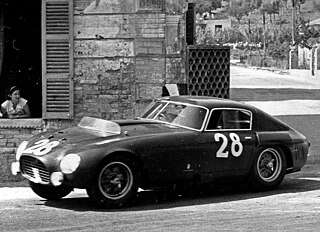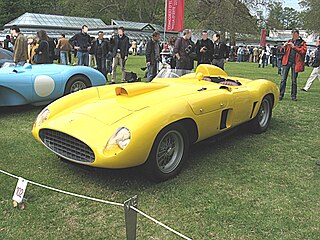
The Ferrari250 Testa Rossa, or 250 TR, is a racing sports car built by Ferrari from 1957 to 1961. It was introduced at the end of the 1957 racing season in response to rule changes that enforced a maximum engine displacement of 3 litres for the 24 Hours of Le Mans and World Sports Car Championship races. The 250 TR was closely related to earlier Ferrari sports cars, sharing many key components with other 250 models and the 500 TR.

The Ferrari 340 Mexico was a Ferrari sports racing car which was intended for the 1952 Carrera Panamericana. It used 4.1 L Lampredi V12 engine producing around 280 PS (206 kW) at 6600 rpm, for a maximum speed of 280 km/h. Just 4 were made in 1952, 3 Vignale Berlinettas and 1 Vignale Spyder; all designed by Giovanni Michelotti. Mexico used a 2,600 mm (102.4 in) wheelbase. Chinetti and Lucas finished the race at third place in berlinetta.

The Ferrari 195 S was a sports racing car produced by Ferrari in 1950. It was an improved version of the 166 MM. The 195 S won Mille Miglia, Coppa della Toscana and Giro delle Calabria.

The Ferrari 225 S was a sports racing car produced by Ferrari in 1952. It was an evolution over the preceding Ferrari 212 Export with important engine upgrades that greatly improved power output. The model was extensively used in competition, winning many international races. The most important include 1952 Monaco Grand Prix for sports cars, Portuguese Grand Prix, Coppa d'Oro di Sicilia, Coppa della Toscana, Coppa d'Oro delle Dolomiti and many others. It was the final Colombo V12 engine iteration before the 250-family stretched it to 3.0-litres capacity.

The Ferrari 212 Export was a sports racing car produced by Ferrari in 1951–1952. The 212 Exports won Tour de France automobile, Giro di Sicilia, Coppa della Toscana, 10 Hours of Messina and other motor races throughout its career. It was meant to be a sports car available for oversea markets.

The Ferrari 375 Plus was a sports racing car produced by Ferrari in 1954. The model competed internationally, winning many major races, including 24 Hours of Le Mans, Carrera Panamericana, 1000km of Buenos Aires, Agadir GP and Silverstone.

The Ferrari 250 Monza was a sports racing car produced by Ferrari in 1954. It was a combination of a stretched chassis and body from the line of inline-four-engined racers with an ubiquitous 3.0-litre Colombo V12 engine.

The Ferrari 315 S was a sports racing car produced by Ferrari in 1957. The model was intended to succeed the Ferrari 290 MM, which had won the 1956 Mille Miglia.

The Ferrari 290 MM was a sports racing car produced by Ferrari in 1956. It was developed to compete in the 1956 edition of Mille Miglia, hence the acronym "MM", and four cars were built.

The Ferrari 335 S was a sports racing car produced by Italian manufacturer Ferrari in 1957. The car was a direct response to the Maserati 450S which with its 4.5-litre engine was threatening to overpower the 3.8-litre 315 S and 3.5-litre 290 MM. Four cars were produced in total.

The Ferrari 375 MM, was a sports racing car produced by Ferrari in 1953 up to 1955 for the road cars. It was named "375" for the unitary displacement of one cylinder in the 4.5 L V12 engine, and the "MM" stood for the Mille Miglia race. In total 26 units were made, including four converted from the 340 MM.

Vittorio Jano designed a new 60° V12 engine for sports car racing for Ferrari. This new engine, introduced in 1956, combined elements of both Colombo and Lampredi engines with new features. Engine architecture was more of Lampredi school but retained smaller Colombo internal measurements. Jano moved to Ferrari along with his designs for the Lancia D50 in 1955 and went on to design not only a new V12 but also a family of the Dino V6 engines soon after. Some of the technical ideas came from the Jano's Lancia V8 DOHC engine, intended for Formula One. This family of engines replaced Lampredi inline-4s known from Ferrari Monza line and went on to win many international races and titles for Ferrari. The design team comprised Jano as well as Vittorio Bellentani, Alberto Massimino, and Andrea Fraschetti.

The Ferrari 410 S was a sports racing car produced by Ferrari in 1955-1956. After the racing successes of 375 Plus, mainly in 1954 Carrera Panamericana, Ferrari decided to prepare another model for this marathon. The 410 S was intended as a long distance race car originally designed for the 1955 Carrera Panamericana and was the final model of the Lampredi V12 sports car lineage. The next generation of sports racing cars that replaced the 410 S were powered by the new Jano V12 engines.

The Ferrari 275 S was a sports racing car produced by Ferrari in 1950. It was the first Ferrari powered by a new Aurelio Lampredi-designed V12 engine, created as a large displacement alternative to the initial 1,5 L Colombo V12, used in supercharged form in Ferrari 125 F1. Formula One regulations allowed for up to 4.5 L in naturally aspirated form.

The Ferrari 250 MM was a sports racing car produced by Ferrari in 1953. After the initial racing successes of the 3.0-litre Colombo V12 engine, introduced in the 250 S one-off, Ferrari produced a serial racing model. It is best recognisable for the distinctive closed berlinetta bodywork by Pinin Farina. The "MM" in its name stood for the Mille Miglia race.

The Ferrari 376 S was a sports racing car produced by Ferrari in 1955. It was the first raced Ferrari powered by a new Aurelio Lampredi-designed inline-6 engine, created as a larger alternative to the inline-4 series of engines used in the Ferrari Monza race cars. The intention behind the development of this model was the 1955 Mille Miglia race. It was yet another attempt by Ferrari to match the new Mercedes-Benz 300 SLR in competition. All of the created cars were further converted into a bigger capacity models.

The Ferrari 735 LM was a sports racing car produced by Ferrari in 1955. It was the second raced Ferrari, powered by an Aurelio Lampredi-designed inline-6 engine, created as a larger displacement evolution to the engines used in the Ferrari Monza race cars.

The Dino 206 S is a sports prototype produced by Ferrari in 1966–1967 under the Dino marque. Ferrari intended to produce at least fifty examples for homologation by the CSI in the Sport 2.0 L Group 4 category. As only 18 were made, the car had to compete in the Prototype 2.0-litre class instead. In spite of this handicap the Dino 206 S took many class wins. The 206 S was the last of the Dino sports racing cars and simultaneously the most produced.

The Ferrari SP was a series of Italian sports prototype racing cars produced by Ferrari during the early 1960s. All featured a rear mid-engine layout, a first for a Ferrari sports car. Major racing accolades include the 1962 European Hill Climb Championship, two overall Targa Florio victories, in 1961 and 1962, and "1962 Coupe des Sports" title.

The Ferrari 412 S was a unique sports racing car produced by Ferrari in 1958. The 412 S combined Ferrari's most powerful V12 engine to date with a one-off experimental racing chassis. It was also incorrectly called as the 412 MI due to being built around an engine from the 500 Miles of Monza racer. The car was created specifically for John von Neumann to take on the American racing cars Scarabs in SCCA racing. Its famed drivers included Phil Hill and Richie Ginther.




















